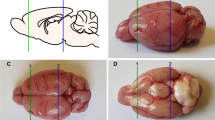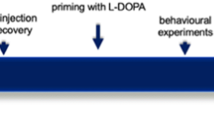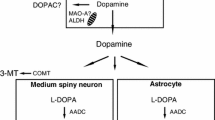Summary
Degeneration of dopaminergic nigrostriatal neurons in Parkinson's disease results in an overactivity of excitatory glutamatergic projections from the subthalamic nucleus to the output nuclei of the basal ganglia resulting in rigidity and akinesia. In theory pharmacological blockade of these overactive systems should improve parkinsonian symptomatology. The selective AMPA-antagonist NBQX and the competitive NMDA-antagonist CPP are not effective in animal models of Parkinson's disease when given alone but ameliorate parkinsonian symptomatology and stimulate locomotor activity when co-administered with a threshold dose of L-Dopa. These synergistic effects are seen in the MPTP-treated (1-methyl-4-phenyl-1,2,3,6-tetrahydropyridine) common marmoset and the rat with unilateral 6-hydroxydopamine (6-OHDA) lesions of the substantia nigra. Therefore competitive NMDA and non-NMDA antagonists may offer a new therapeutic strategy for the treatment of Parkinson's disease.
Similar content being viewed by others
References
Bergman H, Wichmann T, DeLong MR (1990) Reversal of experimental parkinsonism by lesions of the subthalamic nucleus. Science 249: 1436–1438
Brotchie JM, Mitchell IJ, Sambrook MA, Crossman A (1991) Alleviation of parkinsonism by antagonism of excitatory amino acid transmission in the medial segment of the globus pallidus in rat and primate. Movement Disorders 6: 133–138
Burns RS, Chiueh CC, Markey SP, Ebert MH, Jacobowitz DM, Kopin IJ (1983) A primate model of parkinsonism; selective destruction of dopaminergic neurons in the pars compacta of the substantia nigra by N-methyl-4-phenyl-1,2,3,6-tetrahydropyridine. Proc Natl Acad Sci USA 80: 4546–4550
Carlsson M, Carlsson A (1989) Dramatic synergism between MK-801 and clonidine with respect to locomotor stimulatory effect in monoamine-depleted mice. J Neural Transm 77: 65–71
Carpenter MB (1981) Anatomy of the corpus striatum and brain stem integrating systems. In: Brooks VB (ed) Handbook of physiology, sect 1. The nervous system II. American Physiological Society, Bethesda, pp 947–995
Close SP, Elliot PJ, Hayes AG, Marriott AS (1990) Effects of classical and novel agents in a MPTP-induced reversible model of Parkinson's disease. Psychopharmacology 102: 295–300
Crossman AR, Peggs D, Boyce S, Luquin MR, Sambrook MA (1989) Effect of the NMDA antagonist MK-801 on MPTP-induced parkinsonism in the monkey. Neuropharmacology 28: 1271–1273
Davis GC, Williams AC, Markey SP, Ebert MH, Caine ED, Reichert CM, Kopin IJ (1979) Chronic parkinsonism secondary to intravenous injection of meperidine analogues. Psychiatry Res 1: 249–254
Fonnum F (1984) Glutamate: a neurotransmitter in mammalian brain. J Neurochem 42: 1–11
Jenner P, Rupniak NMJ, Rose S, Kelley E, Kilpatrick G, Lees A, Marsden CD (1984) 1-Methyl-4-phenyl-1,2,3,6-tetrahydropyridine-induced parkinsonism in the common marmoset. Neurosci Lett 50: 85–90
Klockgether T, Turski L (1989) Excitatory amino acids and the basal ganglia: implications for the therapy of Parkinson's disease. Trends Neurosci 12: 285–286
Klockgether T, Turski L (1990) NMDA antagonists potentiate antiparkinsonian actions of L-Dopa in monoamine-depleted rats. Ann Neurol 28: 539–546
Klockgether T, Turski L, Löschmann P-A, Wachtel H (1990) N-Methyl-D-aspartate antagonists stimulate locomotor activity in monoamine depleted rats: implications for therapy of Parkinson's disease. In: Lubec G, Rosenthal GA (eds) Amino acids: chemistry, biology and medicine. ESCOM Science Publishers B.V, Leiden, pp 269–275
König JFR, Klippel RA (1963) The rat brain: a stereotaxic atlas of the forebrain and lower parts of the brain stem. William and Wilkins, Baltimore
Kornhuber J, Bormann J, Retz W, Hübers M, Riederer P (1989) Memantine displaces [3H]MK-801 at therapeutic concentrations in postmortem human frontal cortex. Eur J Pharmacol 166: 589–590
Kornhuber J, Bormann J, Hübers M, Rusche E, Riederer P (1991) Effects of the 1-amino-adamantanes at the MK-801-binding site of the NMDA-receptor-gated ion channel: a human postmortem brain study. Eur J Pharmacol (Mol Pharmacol Sect) 206: 297–300
Langston JW, Ballard B, Tetrud JW, Irwin I (1983) Chronic parkinsonism in humans due to a product of meperidineanalog synthesis. Science 225: 1480–1482
Löschmann P-A, Chong PN, Nomoto M, Tepper PG, Horn AS, Jenner P, Marsden CD (1989) Stereoselective reversal of MPTP-induced parkinsonism in the marmoset after dermal application of N-0437. Eur J Pharmacol 166: 373–380
Marsden CD, Parkes JD (1976) On-off effects in patients with Parkinson's disease on chronic levodopa therapy. Lancet i: 292–296
Morelli M, Di Chiara G (1990) MK-801 potentiates dopaminergic D1 but reduces D2 responses in the 6-hydroxydopamine model of Parkinson's disease. Eur J Pharmacol 182: 611–612
Olney JW (1969) Brain lesions, obesity and other disturbances in mice treated with monosodium glutamate. Science 164: 719–721
Olney JW, Price MT, Labruyere J, Salles KS, Frierdich G, Mueller M, Silverman E (1987) Anti-parkinsonian agents are phencyclidine agonists and N-methyl-aspartate antagonists. Eur J Pharmacol 142: 319–320
Olney JW (1989) Excitotoxicity and N-methyl-D-aspartate receptors. Drug Dev Res 17: 299–319
Riederer R, Kornhuber J, Gerlach M, Danielczyk W, Youdim MBH (1991) Glutamatergic-dopaminergic imbalance in Parkinson's disease and paranoid hallucinatory psychosis. In: Rinne UK, Nagatsu T, Horowski R (eds) Proceedings International Workshop Parkinson's Disease: from Basic Research and Early Diagnosis to Long-Term Treatment. Medicom Europe BV, Bussum The Netherlands (in press)
Sheardown MJ, Nielsen EO, Hansen AJ, Jacobsen P, Honoré T (1990) 2,3-Dihydroxy-6-nitro-7-sulfamoyl-benz(F)quinoxaline: a neuroprotectant for cerebral ischaemia. Science 247: 571–574
Troupin AS, Mendius JR, Cheng F (1986) MK 801. In: Meldrum BS, Potter RJ (eds) Current problems in epilepsy 4. New anticonvulsant drugs. John Libbey, London, pp 191–201
Turski L, Bressler K, Rettig K-J, Löschmann P-A, Wachtel H (1991) Protection of substantia nigra from MPP+ neurotoxicity by N-methyl-D-aspartate antagonists. Nature 349: 414–418
Ungerstedt U (1968) 6-Hydroxydopamine induced degeneration of central monoamine neurons. Eur J Pharmacol 5: 107–110
Author information
Authors and Affiliations
Rights and permissions
About this article
Cite this article
Löschmann, P.A., Lange, K.W., Kunow, M. et al. Synergism of the AMPA-antagonist NBQX and the NMDA-antagonist CPP with L-Dopa in models of Parkinson's disease. J Neural Transm Gen Sect 3, 203–213 (1991). https://doi.org/10.1007/BF02259538
Received:
Accepted:
Issue Date:
DOI: https://doi.org/10.1007/BF02259538




